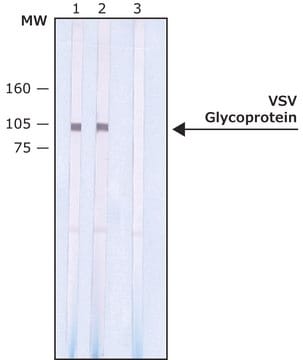A1970
Anti-VSV-Glycoprotein−Agarose antibody, Mouse monoclonal
clone P5D4, purified from hybridoma cell culture, PBS suspension
Synonym(e):
Monoclonal Anti-VSV Glycoprotein
About This Item
Empfohlene Produkte
Biologische Quelle
mouse
Konjugat
agarose conjugate
Antikörperform
purified immunoglobulin
Antikörper-Produkttyp
primary antibodies
Klon
P5D4, monoclonal
Form
PBS suspension
chemische Klasse(n) des Analyten
proteins (VSV-G)
Methode(n)
immunoprecipitation (IP): suitable
protein purification: suitable
Isotyp
IgG1
Kapazität
≥15 nmol/mL, resin binding capacity (VSV-G tagged fusion protein)
Versandbedingung
wet ice
Lagertemp.
2-8°C
Suchen Sie nach ähnlichen Produkten? Aufrufen Leitfaden zum Produktvergleich
Allgemeine Beschreibung
Spezifität
Immunogen
Anwendung
Immunoprecipitation (1 paper)
Physikalische Form
Angaben zur Herstellung
Not finding the right product?
Try our Produkt-Auswahlhilfe.
Lagerklassenschlüssel
10 - Combustible liquids
WGK
nwg
Flammpunkt (°F)
Not applicable
Flammpunkt (°C)
Not applicable
Analysenzertifikate (COA)
Suchen Sie nach Analysenzertifikate (COA), indem Sie die Lot-/Chargennummer des Produkts eingeben. Lot- und Chargennummern sind auf dem Produktetikett hinter den Wörtern ‘Lot’ oder ‘Batch’ (Lot oder Charge) zu finden.
Besitzen Sie dieses Produkt bereits?
In der Dokumentenbibliothek finden Sie die Dokumentation zu den Produkten, die Sie kürzlich erworben haben.
Unser Team von Wissenschaftlern verfügt über Erfahrung in allen Forschungsbereichen einschließlich Life Science, Materialwissenschaften, chemischer Synthese, Chromatographie, Analytik und vielen mehr..
Setzen Sie sich mit dem technischen Dienst in Verbindung.







